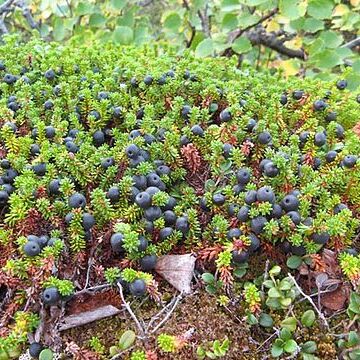Shrubs. Stems prostrate, trailing, (densely branched, 0.5-1 m, woody); branchlets glabrous or sparsely to densely hairy or glandular distally. Leaves persistent, whorled or spirally arranged; petiole present, (very short); blade (lustrous or opaque, linear, oblong, or elliptic), coriaceous, margins entire, (strongly revolute, enclosing abaxial surface and forming waxy stomatal cavity appearing as groove, surfaces glabrous, glandular, or hairy). Inflorescences solitary flowers (borne on short shoots from axils of distal leaves); perulae absent. Flowers unisexual or bisexual (plants synoecious, sometimes polygamous, or dioecious), radially symmetric; sepals 3, distinct, (oblong); petals 3, (white), corolla deciduous (hence reports of apetalous flowers), oblanceoloid; stamens (2-)4(-6) (staminate flowers usually with 3 stamens), exserted; anthers without awns, dehiscent from slits; ovary 6-9-locular; style exserted; stigma branched. Fruits drupaceous, globose, fleshy, enclosed by nonfleshy calyx. Seeds 6-9, ovoid, not winged, not tailed; testa smooth or with minute spicules. x = 13.
More
Fls unisexual or (ours) often perfect; sep, pet, and stamens each 4; filaments elongate; ovary depressed-globose, 6–9-locular; style very short, with 6–9 expanded, spreading, toothed or lobed stigmas; fr a drupe with 6–9 stones, the style persistent; dwarf, much-branched shrubs with greenish or purplish fls subsessile in the axils; x=13. 2, mainly cool N. Hemisphere.

